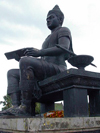|
Ramkhamhaeng (รามคำแหง)
Thai. ‘Rama the brave’.
King of
Sukhothai
from
AD 1279 to 1298 and one of the three kings of the
Lan Na Kingdom
(fig.),
as well as the designer of the Thai script (fig.).
He got his
name from his father at the age of 19, after intervening in a battle in which
he drove away the enemy by charging his
elephant, named
Bekphon,
pushing it ahead in front of the opponent's elephant and beating it.
He was born in 1247 AD and
in
his youth, he was a student of the hermit
Suktantha
at
Lavo.
During his reign, absolute monarchy
commenced and
Theravada Buddhism, introduced by Indian missionaries
from Sri Lanka, was adopted as the official religion.
He passed away in
1298, at the age of 52,
and is one of the Great Kings in Thai history referred to as a
Maha Raj.
As such, his statue (fig.)
is included in the monument at
Uthayaan Rachaphak
(fig.).
There is a Thai university (map
-
fig.) named after him, of which the
Bangkok
branch is located on a main
road of the same name, and his statue features
on 20
baht
banknotes issued in 2013.
In January 2025, Ramkhamhaeng University
for the first time held the Ramkhamhaeng Fair (vdo),
an exciting new event with hopes of becoming an annual tradition in
the future.
Since King
Mongkhut (Rama IV
-
fig.),
discovered the
famous
Stone of Ramkhamhaeng,
known as Inscription Nš 1 (fig.),
at
Prasat Hill in Sukhothai on 17
January 1833, the Thai Cabinet resolved to declare January 17 of
every year as King Ramkhamhaeng the Great Day, an important
historical day, since 17
January
1990. See also
Sukhothai
Historical Park,
Bell of Ramkhamhaeng
and
list of Thai Kings.
Sometimes transliterated Ramkamhaeng.
WATCH VIDEO (1)
and
(2),
VIDEO (E), and
MORE ON THIS.
回






|

